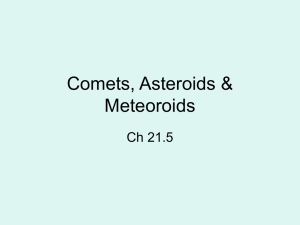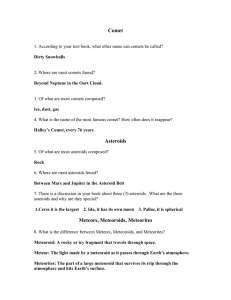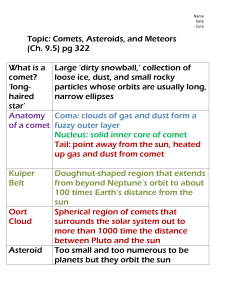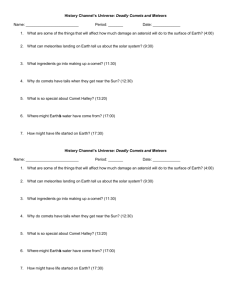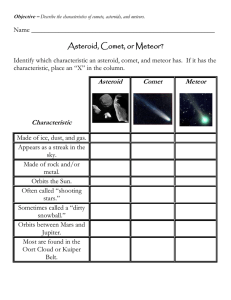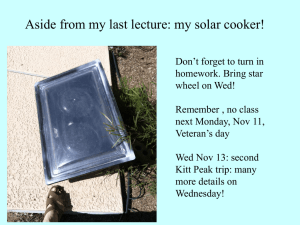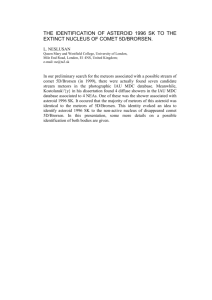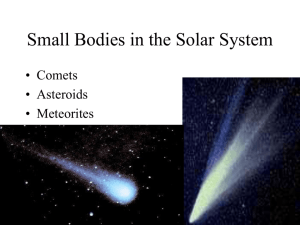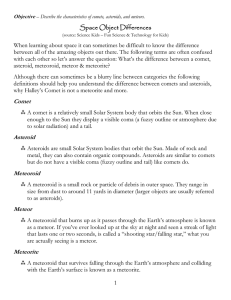C19: Meteors, Asteroids, Comets
advertisement
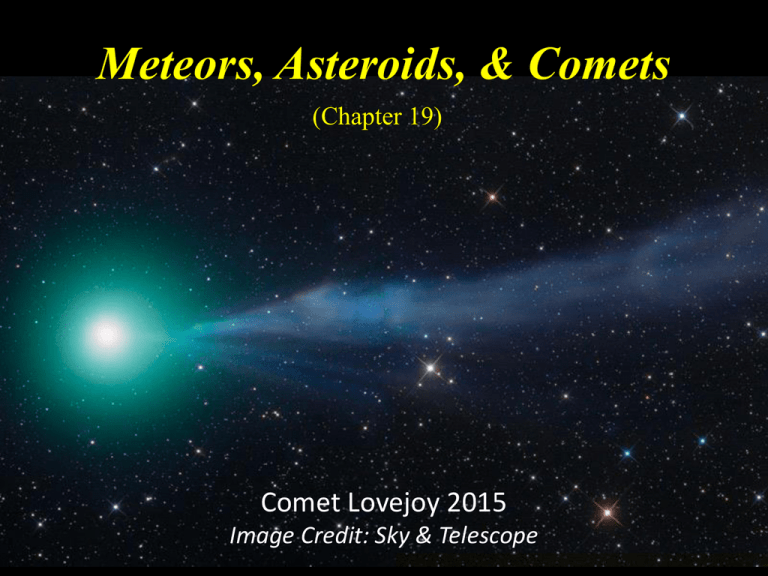
Meteors, Asteroids, & Comets (Chapter 19) Comet Lovejoy 2015 Image Credit: Sky & Telescope Student Learning Objectives • Classify & describe meteors, asteroids, and comets • Identify the locations of these objects in our solar system What is the origin of meteors? These bits of matter have two origins. 1. Asteroid Collisions (bits of rock are ejected) Single Meteor 2. Comet trails (bits of comet along path) Meteor Shower Classifying Rocky Debris Object Location Description Meteoroid Space Orbit Sun Meteor Earth’s Atmosphere “Shooting Star” Earth’s Surface Impact Earth (2/year) Meteorite Astronaut Photographs Perseid Meteor... From Space Aug 14, 2011 Discovery News “Falling Stars” Meteors are fast! 22,000 - 89,000 mph KE huge Meteors heat up in the Earth’s atmosphere Heat makes meteor bright Meteor showers come from the same direction. (radiant) http://stardate.org/nightsky/meteors Practice 1) What is the correct name for a “falling star”? 2) What is the probability of being hit by an object falling from the sky? http://geology.com/meteor-impact-craters.shtml http://neo.jpl.nasa.gov/orbits/ http://szyzyg.arm.ac.uk/~spm/neo_map.html Sixty-five million years ago, about 70% of all species disappeared within a very short period. This was called the Cretaceous-Tertiary Mass Extinction, or K-T Event. Many theorize that this was the result of a giant impact. What are the locations of asteroid groups? Asteroids are leftover rocky planetesimals. Most asteroids are located in the main asteroid belt between 2.3 and 3.3 AU. Irregular shapes Rotation 3-20 hours Some binary systems Some differentiated APOD APOD Kirkwood Gaps Apollo Asteroids Apollo asteroids orbit within the inner solar system, crossing Earth’s orbit. Impact Earth (1/ 250,000 years) Trojan Asteroids Trojan asteroids are located on Jupiter’s orbit. One group ahead One group behind Asteroids maintain well established orbits. No. Collisions = 1 per Million years Collisions result in debris with different compositions. Why? Practice 1) What is the origin of a single meteor? 2) What is the origin of a meteor shower? 3) Why are asteroids irregularly shaped, not spherical like planets? What is the structure of a comet? Comets are leftover icy planetesimals. Ices (NH3, CH4, CO2, & H2O) Silicates The nucleus is an irregularly shaped solid ball of ices with dust grains. The coma is a sphere of tenuous gas and dust that surrounds the nucleus. (Ices vaporize) Comet Halley's Nucleus APOD 2010 January 4 The coma stretches into two tails. Gas tail points away from Sun (ionized gasses) Dust tail follows orbit of comet http://www.st-andrews.ac.uk/~bds2/ltsn/ljm/JAVA/COMETORB/COMET.HTM Three Month Composite of Comet Holmes APOD 2008 February 5 Location of Comets Outermost region of our solar system Kuiper Belt (30-55 AU) Beyond Neptune Oort Cloud (5,000-100,000 AU) A passing star can alter the comet orbit Practice 1) Which tail is typically seen with your eyes? 2) Does a comet always have a tail? 3) Not all comets return to the inner solar system. What are the possible reasons for this?
